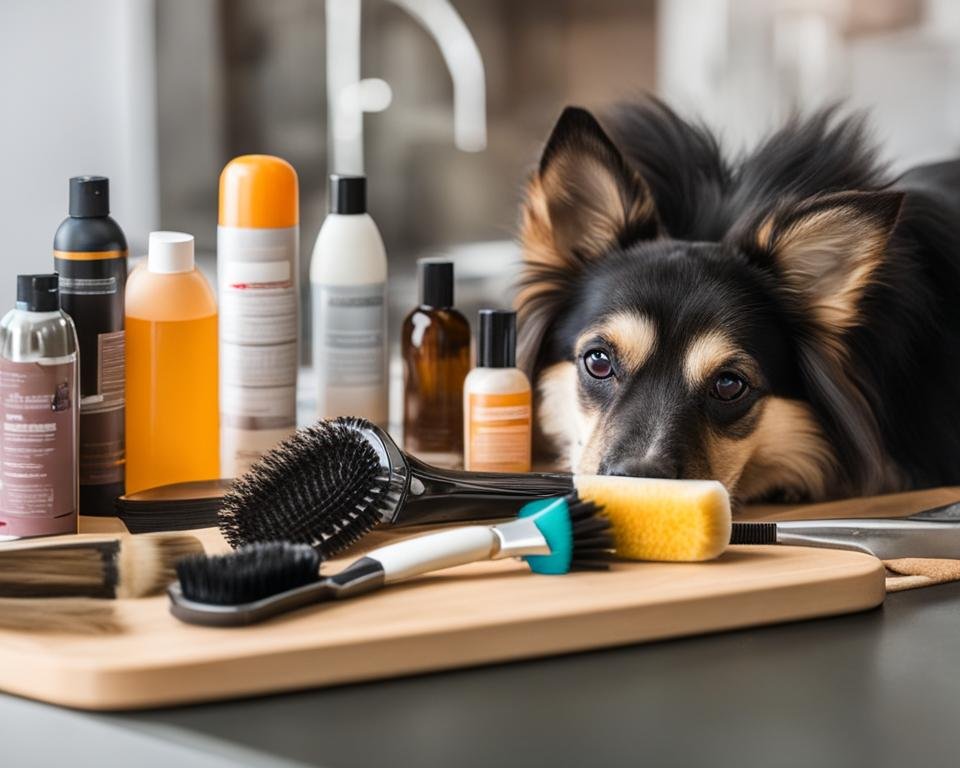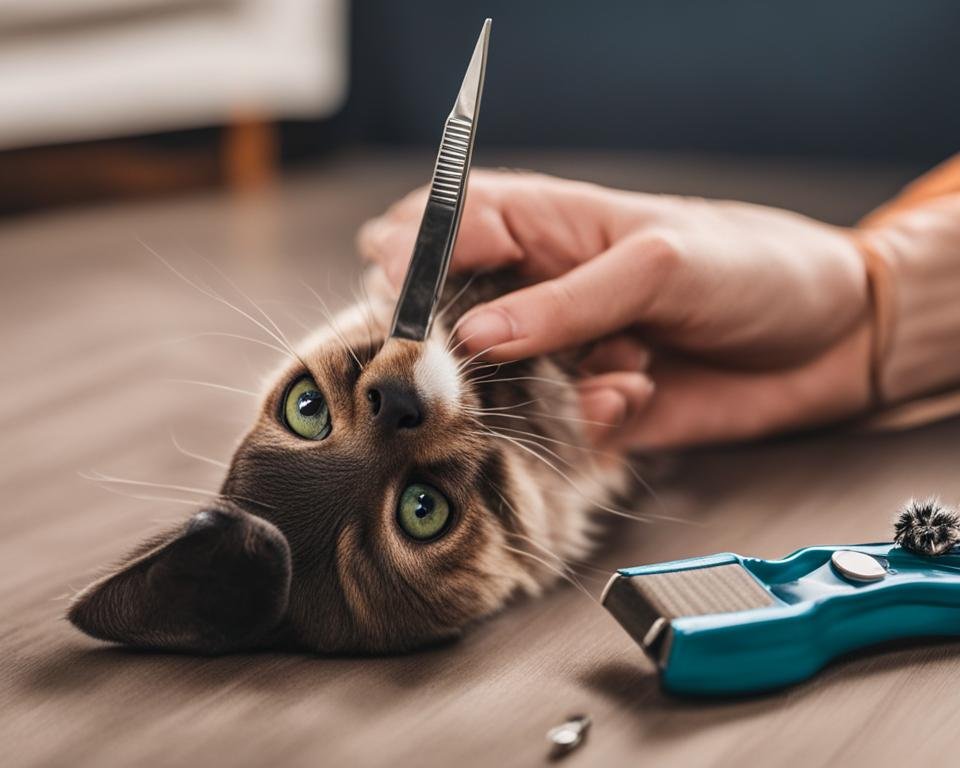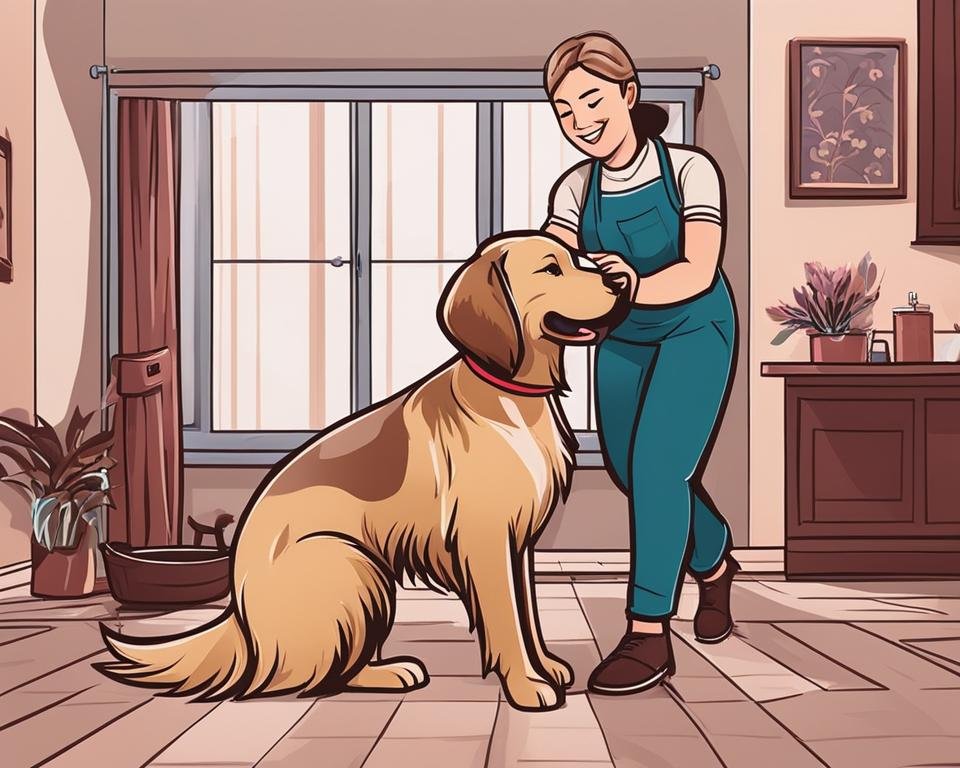Grooming your pets at home can be a rewarding and cost-effective way to keep them looking their best. In this comprehensive guide, we will provide expert tips and techniques to help you master the basics of DIY pet grooming. From understanding the importance of regular grooming to learning essential tools and techniques, we’ll cover everything you need to know to give your furry friends a professional-level grooming experience in the comfort of your own home.
Key Takeaways:
- DIY pet grooming allows you to save money and bond with your pet.
- Regular grooming is crucial for your pet’s health and preventing common issues.
- Choosing the right tools, such as brushes and clippers, is essential for a successful DIY grooming session.
- Adopting a professional approach to grooming ensures salon-quality results at home.
- Proper preparation and techniques are vital for bathing, brushing, clipping, and trimming your pet.
Understanding the Importance of Regular Pet Grooming
Regular grooming is crucial for the overall health and well-being of your pet. It goes beyond just making them look good; it plays a significant role in their overall comfort and happiness. Here, we will explore the importance of pet grooming and the benefits it brings to your furry companion.
One of the key benefits of regular grooming is the prevention of matting. Mats are tangles of hair that can form when your pet’s fur is not properly brushed or maintained. Not only do these mats cause discomfort and pain, but they can also lead to more serious skin issues, such as skin infections.
Grooming also helps in maintaining a healthy coat and skin. Regular brushing stimulates the skin and distributes natural oils throughout the fur, promoting a healthier and shinier coat. Additionally, grooming allows you to keep an eye out for any signs of fleas, ticks, or skin irritations, enabling early detection and treatment.
Beyond the physical benefits, grooming provides an opportunity to bond with your pet. The grooming process involves gentle touch, grooming tools, and attention, all of which contribute to building trust and strengthening the pet-owner relationship. It allows you to spend quality time with your pet, fostering a deeper connection and improving their overall well-being.
Furthermore, regular grooming helps to keep your pet comfortable. Trimming nails, cleaning ears, and maintaining dental hygiene are crucial aspects of grooming that can prevent discomfort and potential health issues. By attending to their grooming needs, you can ensure that your pet is happy, healthy, and free from any unnecessary discomfort.
By understanding the importance of regular pet grooming, you can actively contribute to your pet’s overall health and well-being, while also enjoying the many benefits it brings. So, make grooming a regular part of your pet’s routine and watch them thrive!
Essential Grooming Tools for DIY Pet Grooming
When it comes to grooming your pet at home, having the right tools is essential. These tools will not only help you achieve professional-level results but also ensure a comfortable and stress-free grooming experience for your furry friend. Here are some must-have grooming tools to add to your DIY pet grooming kit:
Choosing the Right Brush and Comb
One of the most important tools in your grooming arsenal is a brush and comb. The type of brush and comb you choose will depend on your pet’s coat type. For example:
- Slicker brushes: Ideal for removing tangles, mats, and loose hair from pets with medium to long coats.
- Bristle brushes: Suitable for maintaining the coat’s shine and removing loose hair from short-haired breeds.
- Undercoat rakes: Designed to remove loose undercoat hair and prevent shedding in double-coated breeds.
Combining the right brush and comb will help prevent matting, keep your pet’s coat healthy, and make the grooming process more enjoyable for both of you.
Investing in Professional-Grade Clippers
If you plan to trim your pet’s coat or perform more advanced grooming tasks, investing in professional-grade clippers is a wise choice. These clippers are specifically designed for pet grooming, ensuring precision, safety, and efficiency. Look for clippers with adjustable blades, quiet operation, and ergonomic designs for maximum comfort and control.
Determining the Need for Specialized Grooming Tools
In addition to brushes and clippers, there are specialized grooming tools that may be necessary for specific grooming tasks. These tools can include nail trimmers, ear cleaning solutions, toothbrushes, and deshedding tools. Assess your pet’s grooming needs and consult with a professional groomer or veterinarian if you’re unsure about the specific tools required.
By equipping yourself with these essential grooming tools, you’ll be well-prepared to provide your pet with the care they deserve and achieve professional grooming results from the comfort of your home.
The Professional Approach to DIY Dog Grooming
Adopting a professional approach to DIY dog grooming involves following industry-standard techniques and best practices. By learning the proper grooming techniques used by professional groomers, you can achieve salon-quality results at home. From prepping your dog for grooming to mastering the clipping and scissoring techniques, we’ll guide you through every step of the process.
Pre-Grooming Preparation: Setting the Stage for Success
Proper pre-grooming preparation is essential to ensure a successful and stress-free grooming session. Before diving into the actual grooming process, it’s important to get your pet ready both mentally and physically. By following these tips, you can create a positive grooming experience for both you and your furry friend.
Mentally Preparing Your Pet
Grooming can be an unfamiliar and sometimes intimidating experience for pets. To help alleviate any anxiety or stress, it’s crucial to gradually introduce them to the grooming process. Here are a few tips for mentally preparing your pet:
- Start early: The earlier you begin exposing your pet to grooming activities, the more comfortable they will become over time.
- Handle your pet regularly: Get your pet used to being touched and handled in areas that will be groomed.
- Desensitize your pet to grooming tools: Gradually introduce grooming tools such as brushes, combs, and clippers to your pet, allowing them to sniff and explore the tools without any grooming activity.
Physical Preparations for Grooming
In addition to mental preparation, it’s important to physically prepare your pet for grooming. Here are a few tips to get your pet ready:
- Bathe your pet prior to grooming: Giving your pet a bath before the grooming session will help remove any dirt or debris from their coat, making the grooming process more effective.
- Brush your pet’s coat: Thoroughly brush your pet’s coat to remove any tangles or mats before grooming. This will make it easier for you to work through their fur during the grooming session.
- Trim excess hair around sensitive areas: If necessary, trim any long hair around your pet’s eyes, ears, and private areas. This will help prevent discomfort and make grooming those areas easier.

Note: The image above depicts a pet being groomed, highlighting the importance of proper preparations for a successful grooming session.
By taking the time to mentally and physically prepare your pet for grooming, you can create a calm and comfortable environment that sets the stage for a successful grooming session. Remember, patience and positive reinforcement are key when introducing your pet to the grooming process.
DIY Pet Grooming Techniques: Bathing Your Dog at Home
Bathing your dog is an essential part of the grooming process. By giving your furry friend a regular bath, you can keep their coat clean, remove dirt and odors, and promote healthy skin. In this section, we’ll guide you through the steps of bathing your dog at home, ensuring a comfortable and enjoyable experience for both you and your pet.
Effective Shampoo and Conditioning Tips
Choosing the right shampoo and conditioner for your dog is crucial for maintaining their coat’s health and appearance. Consider their specific needs, such as dry or sensitive skin, and select products formulated for dogs. Avoid using human shampoos as they can be too harsh for their delicate skin. Additionally, opt for all-natural or hypoallergenic products to minimize the risk of skin irritation or allergies.
When bathing your dog, follow these tips:
- Thoroughly wet your dog’s coat with warm water before applying shampoo.
- Massage the shampoo gently into their fur, working up a rich lather.
- Pay special attention to areas prone to dirt and oil buildup, such as the neck, armpits, and tail.
- Rinse your dog thoroughly to remove all traces of shampoo.
- Apply conditioner if necessary, focusing on the ends of the fur to prevent matting.
- Rinse again until all conditioner is washed out.
Best Practices for Safely Drying Your Pet after a Bath
After bathing your dog, it’s important to dry them properly to prevent skin irritation or discomfort. Here are some best practices to follow:
- Wrap your dog in a clean, absorbent towel to remove excess water. Gently pat their fur, avoid rubbing vigorously.
- If your dog has a thick or long coat, consider using a blow dryer on a low, cool setting to speed up the drying process. Keep the dryer at a safe distance from your dog to prevent burns.
- Regularly check their ears to ensure they are dry, as moist ears can lead to infections.
- Brush their coat gently once it is completely dry to remove any tangles or mats.
By following these DIY dog bathing techniques, you can maintain your pet’s cleanliness and promote their overall well-being.
Mastering the Brushing Technique: Tips and Tricks
Brushing is a fundamental grooming technique that plays a vital role in maintaining the health and appearance of your pet’s coat. Whether you have a long-haired or short-haired dog, regular brushing is essential to keep their fur free from tangles, mats, and excessive shedding. In this section, we will share some valuable tips and tricks to help you master the brushing technique and ensure your pet’s coat stays in optimum condition.
Using the Right Brush for Your Dog’s Coat Type
When it comes to brushing your dog, using the right brush for their specific coat type is crucial. Different breeds have different coat textures and lengths, and using the appropriate brush will make the brushing process more efficient and effective. Here are some common brush types and their suitable coat types:
| Brush Type | Suitable Coat Types |
|---|---|
| Bristle Brush | Short-haired breeds with smooth coats |
| Slicker Brush | Medium to long-haired breeds with dense, curly, or wavy coats |
| Undercoat Rake | Breeds with double coats or heavy shedding |
| Pin Brush | Long-haired breeds with silky or curly coats |
Using the right brush for your dog’s coat type will ensure effective removal of loose hair, prevent matting, and leave their coat looking its best.
Avoiding Common Mistakes When Brushing Your Dog
While brushing your dog may seem straightforward, it’s important to be aware of common mistakes that pet owners often make. Avoiding these mistakes will help maintain your pet’s coat health and prevent any discomfort during the grooming process. Here are some common mistakes to avoid:
- Brushing too aggressively: Be gentle and use a light touch when brushing to avoid causing discomfort or skin irritation.
- Ignoring sensitive areas: Pay attention to sensitive areas like the ears, belly, and tail, and use gentle strokes in those areas.
- Not brushing frequently enough: Regular brushing is key to preventing matting and keeping your dog’s coat healthy. Aim for a brushing session at least once a week, or more often for breeds that require more frequent grooming.
- Using the wrong brush: As mentioned earlier, using the right brush for your dog’s coat type is essential. Using the wrong brush can be ineffective and potentially cause discomfort.
By avoiding these common mistakes and applying the proper brushing technique, you can ensure a positive grooming experience for both you and your furry friend.
Step-by-Step Pet Grooming Tutorial for Clipping and Scissoring
Grooming your pet’s coat through clipping and scissoring requires precision and skill. Follow our step-by-step tutorial to achieve a professional-looking groom at home. We will cover the necessary tools, techniques, and safety precautions to ensure a smooth and comfortable grooming experience for your pet.
Before you begin, make sure you have the following tools:
- Clippers with appropriate blade attachments
- Scissors with rounded tips
- Grooming comb
- Grooming table or sturdy surface
- Styptic powder in case of minor cuts
Prior to clipping and scissoring, ensure that your pet is clean and dry. Brush out any knots or tangles in their coat using a grooming comb. It’s important to work with a calm and cooperative pet, so consider desensitizing them to the sound and vibration of the clippers before starting.
Step 2: Start with the clippers
Begin by using the clippers to trim the fur in the desired areas. Use a comb attachment for an even cut, or switch to a shorter attachment for areas that require more precision, such as the face and paws. Remember to go slow and steady, following the natural direction of hair growth.
Step 3: Use scissors for fine-tuning
Once you have trimmed the bulk of the fur with the clippers, switch to the scissors to refine the shape and length. Trim any stray hairs or uneven sections, being careful not to cut too close to the skin. Keep the tips of the scissors angled away from your pet to prevent accidental injury.
Step 4: Pay attention to sensitive areas
When grooming sensitive areas such as the ears, tail, and groin, exercise extra caution. Use the scissors to carefully trim the fur in these delicate areas, ensuring not to nick or irritate the skin. Take breaks as needed to give your pet a rest and prevent them from becoming overwhelmed.
Step 5: Monitor your pet’s comfort
Throughout the grooming process, observe your pet for any signs of discomfort or distress. If they become restless or exhibit stress signals, take a break and offer reassurance. Remember to reward your pet with praise and treats for their patience and cooperation.
Step 6: Clean up and finishing touches
Once you have completed the clipping and scissoring process, comb through your pet’s coat to remove any loose hairs or tangles. Gently check for any missed spots or uneven areas, and make necessary adjustments with the clippers or scissors.
Step 7: Final safety checks
Before concluding the grooming session, inspect your pet’s coat for any cuts or irritations. If you notice any minor cuts, apply styptic powder to stop bleeding. Ensure that all tools are safely stowed away and clean up any grooming debris.
Now, you have successfully completed the clipping and scissoring process, providing your pet with a professional-looking groom from the comfort of your own home. Remember to practice patience and always prioritize your pet’s safety and comfort throughout the grooming session.
Trimming Your Pet’s Nails: A Vital Component of Home Care
Trimming your pet’s nails is a crucial part of their overall grooming routine. It not only helps prevent discomfort and potential injuries but also ensures their comfort and mobility. In this section, we will provide you with the necessary tools and techniques for a stress-free nail trimming experience for your beloved pet.

Tools and Techniques for a Stress-Free Experience
When it comes to DIY pet nail trimming, having the right tools is essential. Here are the tools you’ll need:
- Nail clippers or a nail grinder
- Styptic powder or cornstarch (to stop bleeding if a nail is accidentally cut too short)
- Treats or rewards (to keep your pet calm and motivated)
To ensure a stress-free nail trimming experience, follow these steps:
- Choose a quiet and well-lit area where you and your pet feel comfortable.
- Begin by gently handling your pet’s paws to get them used to the sensation.
- Gradually introduce them to the nail clippers or grinder, allowing them to sniff and investigate.
- Hold your pet’s paw firmly but gently, making sure not to squeeze or apply pressure.
- Trim or grind a small portion of the nail at a time, taking care to avoid cutting the quick (the blood vessel inside the nail).
- Monitor your pet’s reaction and stop if they become stressed or anxious. It’s better to take breaks and continue later than to rush the process.
- Remember to reward your pet with treats and praise after each successful trimming session.
By using the right tools and employing these techniques, you can make nail trimming a positive experience for both you and your pet.
How to Handle Nail Trimming Complications
Occasionally, you may encounter complications while trimming your pet’s nails. It’s important to know how to handle these situations:
- Overgrown nails: If your pet’s nails have grown too long, trim a small portion at a time over multiple sessions to avoid cutting into the quick.
- Resistance or anxiety: Some pets may resist nail trimming due to fear or anxiety. Take it slow and try using positive reinforcement techniques, such as treats and praise, to help your pet relax.
- Bleeding: Accidentally cutting the quick can cause bleeding. If this happens, apply styptic powder or cornstarch to the nail tip to stop the bleeding. Seek veterinary assistance if bleeding persists or if you are unsure how to handle the situation.
Remember, patience and gentle handling are key when it comes to nail trimming. If you are unsure or uncomfortable with trimming your pet’s nails, consult a professional groomer or veterinarian for assistance.
Navigating the Challenges of At-Home Pet Grooming
DIY pet grooming can come with its own set of challenges. As pet owners, we understand the difficulties that can arise when trying to groom our furry friends at home. From handling anxious pets to managing difficult coat types and dealing with grooming-related injuries, these challenges can make the grooming process overwhelming. However, with the right knowledge and strategies, it is possible to overcome these obstacles and ensure a successful grooming experience for both you and your pet.
One common challenge pet owners face is handling anxious pets during grooming sessions. Some pets may become stressed or fearful when subjected to grooming activities, making it challenging to complete tasks such as brushing, bathing, or nail trimming. To address this challenge, it is essential to create a calm and comfortable environment for your pet. Gradual desensitization, positive reinforcement, and using calming techniques can help alleviate anxiety and make grooming more manageable.
Another challenge is managing difficult coat types. Certain breeds or individual pets may have coats that are prone to matting, tangling, or excessive shedding. These coat types require additional attention and specialized grooming techniques. Understanding your pet’s coat type and investing in the right grooming tools can make a significant difference. Regular brushing, using the appropriate brushes and combs, and maintaining a consistent grooming routine can help keep difficult coats in good condition.
Grooming-related injuries can also pose a challenge for pet owners. Accidents such as nicks, cuts, or skin irritations can happen, especially when using sharp tools or unfamiliar grooming techniques. To mitigate the risk of injuries, it is crucial to prioritize safety during the grooming process. Using clippers and scissors carefully, keeping your pet calm and properly secured, and seeking professional guidance when needed can help prevent grooming-related accidents.
DIY Cat Grooming Techniques for Your Feline Friend
Grooming cats can be a different experience compared to grooming dogs. Cats are known for their grooming habits, but sometimes they need a little extra help to keep their coats healthy and looking their best. In this section, we will provide you with DIY cat grooming tips and techniques to help you take care of your feline friend’s grooming needs.
Understanding the Unique Aspects of Cat Grooming
Cat grooming involves more than just brushing their coat. Cats have unique grooming needs that require specific techniques and tools. Unlike dogs, cats are generally not fond of water, so bathing them can be a challenge. They also require regular nail trimming to prevent their claws from becoming too long and causing discomfort. Understanding these unique aspects of cat grooming will help you provide the best care for your cat.
How to Keep Your Cat Calm During Grooming Sessions
Keeping your cat calm during grooming sessions is crucial for a successful experience. Cats can be easily stressed, so it’s important to create a calm and comfortable environment. Here are some tips to help you keep your cat calm:
- Choose a quiet and familiar grooming area
- Use gentle and slow movements
- Provide treats or distractions to keep your cat occupied
- Use positive reinforcement and reward your cat for good behavior
- Take breaks if your cat becomes anxious or agitated
By implementing these techniques, you can create a positive grooming experience for your cat.
Conclusion
In conclusion, the DIY pet grooming guide provides a comprehensive resource for pet owners looking to take care of their furry friends at home. By mastering the basics of at-home grooming, you can save time and money while ensuring your pet’s well-being.
Grooming your pet at home allows for a professional-level grooming experience, creating a stronger bond between you and your pet. It’s important to prioritize their comfort and safety throughout the grooming process. If you encounter any complex grooming tasks or feel unsure, don’t hesitate to seek professional help.
Remember, DIY pet grooming can be a fulfilling and rewarding endeavor. By following the techniques and best practices outlined in this guide, you’ll be equipped to provide your pets with the care they deserve. So grab your grooming tools, show your pets some love, and embark on a grooming journey like no other.
FAQ
Why is regular pet grooming important?
Regular grooming is important for the overall health and well-being of your pet. It helps prevent matting, skin infections, and other common issues. Grooming also provides an opportunity to bond with your pet and keep them comfortable.
What tools do I need for DIY pet grooming?
To groom your pet at home, you’ll need brushes, combs, clippers, and specialized tools for specific grooming needs. Choosing the right brush and comb for your pet’s coat type is essential. Investing in professional-grade clippers will help you achieve salon-quality results.
What are the best practices for DIY dog grooming?
Adopting a professional approach to DIY dog grooming involves following industry-standard techniques and best practices. By learning proper grooming techniques, you can achieve salon-quality results at home.
How can I prepare my pet for grooming at home?
Proper pre-grooming preparation is essential to ensure a successful and stress-free grooming session. This includes desensitizing your pet to grooming tools and creating a positive grooming environment.
How do I bathe my dog at home?
To bathe your dog at home, choose the right shampoo and conditioner for their specific needs. We’ll walk you through the steps of safely drying your pet after a bath to avoid skin irritation.
What is the proper brushing technique for dogs?
Brushing is a fundamental grooming technique. Using the right brush for your dog’s specific coat type is important to prevent tangles, mats, and excessive shedding.
How do I clip and scissor my pet’s coat at home?
Clipping and scissoring are advanced grooming techniques. We’ll provide a step-by-step tutorial on how to achieve a professional-looking groom, including the necessary tools and safety precautions.
How do I trim my pet’s nails at home?
Trimming your pet’s nails is essential for their comfort and mobility. We’ll guide you through the tools and techniques for a stress-free nail trimming experience.
What are some common challenges of DIY pet grooming?
DIY pet grooming comes with its own set of challenges, such as handling anxious pets, managing difficult coat types, and dealing with grooming-related injuries. We’ll provide practical tips and solutions to help you overcome these challenges.
How do I groom my cat at home?
Grooming cats can be a different experience compared to grooming dogs. We’ll cover DIY cat grooming techniques, including understanding the unique aspects of cat grooming and tips for keeping your cat calm during grooming sessions.









